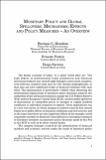Artículo
Monetary policy and global spillovers: mechanisms effects and policy measures: an overview
Fecha
2018Resumen
The global economy of today 'is a small world after all.' The high degree of international trade integration and financial interconnectedness has created tight linkages across most countries even between countries that may be very distant geographically or that may not have significant trade or financial relations with each other. This phenomenon is particularly evident when observing the international implications of monetary policy decisions made by the authorities of key advanced economies mainly the U.S. Federal Reserve (Fed) and the European Central Bank (ECB) and the global spillovers of fluctuations in commodity prices or changes in capital markets conditions in individual countries or regions. These implications run in a two-way street in which changes in interest rates by key central banks have global effects on financial conditions and real activity and at the same time there are also important effects of for example world commodity markets or financial vulnerabilities in emerging economies or Eurozone members on monetary policy decisions made by the Fed or the ECB as well as by other central banks.
Colecciones
Descargar


